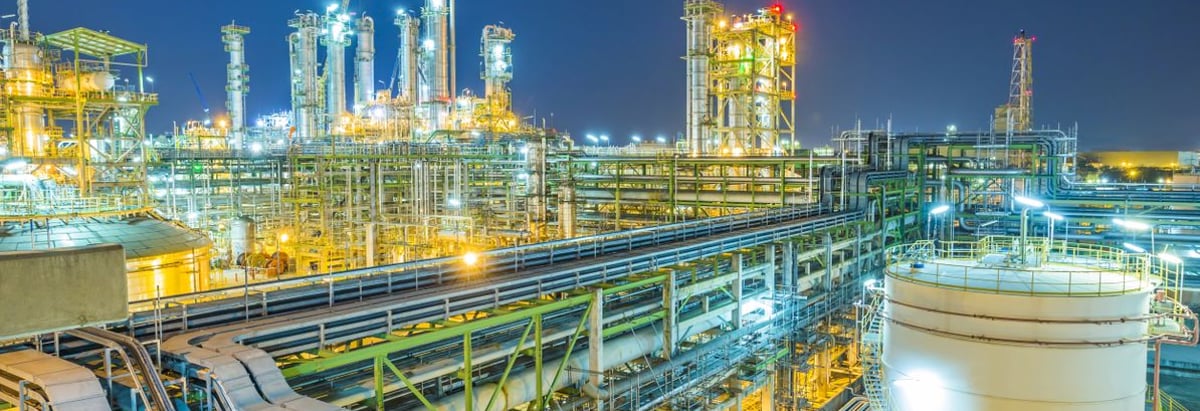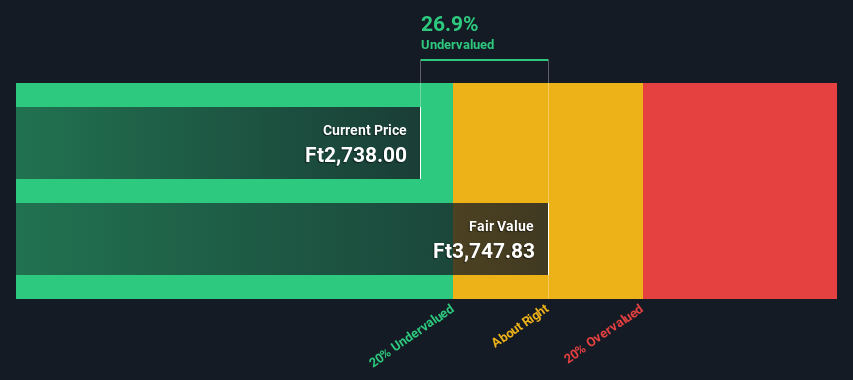- Hungary
- /
- Oil and Gas
- /
- BUSE:MOL
MOL Magyar Olaj- és Gázipari Nyilvánosan Muködo Részvénytársaság's (BUSE:MOL) Intrinsic Value Is Potentially 37% Above Its Share Price

Key Insights
- MOL Magyar Olaj- és Gázipari Nyilvánosan Muködo Részvénytársaság's estimated fair value is Ft3,748 based on 2 Stage Free Cash Flow to Equity
- MOL Magyar Olaj- és Gázipari Nyilvánosan Muködo Részvénytársaság's Ft2,738 share price signals that it might be 27% undervalued
- Our fair value estimate is 18% higher than MOL Magyar Olaj- és Gázipari Nyilvánosan Muködo Részvénytársaság's analyst price target of Ft3,179
Does the August share price for MOL Magyar Olaj- és Gázipari Nyilvánosan Muködo Részvénytársaság (BUSE:MOL) reflect what it's really worth? Today, we will estimate the stock's intrinsic value by taking the expected future cash flows and discounting them to their present value. The Discounted Cash Flow (DCF) model is the tool we will apply to do this. Before you think you won't be able to understand it, just read on! It's actually much less complex than you'd imagine.
We would caution that there are many ways of valuing a company and, like the DCF, each technique has advantages and disadvantages in certain scenarios. If you want to learn more about discounted cash flow, the rationale behind this calculation can be read in detail in the Simply Wall St analysis model.
See our latest analysis for MOL Magyar Olaj- és Gázipari Nyilvánosan Muködo Részvénytársaság
Step By Step Through The Calculation
We are going to use a two-stage DCF model, which, as the name states, takes into account two stages of growth. The first stage is generally a higher growth period which levels off heading towards the terminal value, captured in the second 'steady growth' period. To start off with, we need to estimate the next ten years of cash flows. Where possible we use analyst estimates, but when these aren't available we extrapolate the previous free cash flow (FCF) from the last estimate or reported value. We assume companies with shrinking free cash flow will slow their rate of shrinkage, and that companies with growing free cash flow will see their growth rate slow, over this period. We do this to reflect that growth tends to slow more in the early years than it does in later years.
Generally we assume that a dollar today is more valuable than a dollar in the future, so we discount the value of these future cash flows to their estimated value in today's dollars:
10-year free cash flow (FCF) estimate
| 2024 | 2025 | 2026 | 2027 | 2028 | 2029 | 2030 | 2031 | 2032 | 2033 | |
| Levered FCF (HUF, Millions) | Ft476.5b | Ft422.0b | Ft423.0b | Ft353.5b | Ft333.2b | Ft321.2b | Ft314.4b | Ft311.0b | Ft309.9b | Ft310.5b |
| Growth Rate Estimate Source | Analyst x4 | Analyst x4 | Analyst x2 | Analyst x2 | Est @ -5.74% | Est @ -3.61% | Est @ -2.12% | Est @ -1.07% | Est @ -0.34% | Est @ 0.17% |
| Present Value (HUF, Millions) Discounted @ 16% | Ft411.8k | Ft315.3k | Ft273.1k | Ft197.3k | Ft160.7k | Ft133.9k | Ft113.3k | Ft96.9k | Ft83.4k | Ft72.2k |
("Est" = FCF growth rate estimated by Simply Wall St)
Present Value of 10-year Cash Flow (PVCF) = Ft1.9t
We now need to calculate the Terminal Value, which accounts for all the future cash flows after this ten year period. For a number of reasons a very conservative growth rate is used that cannot exceed that of a country's GDP growth. In this case we have used the 5-year average of the 10-year government bond yield (1.4%) to estimate future growth. In the same way as with the 10-year 'growth' period, we discount future cash flows to today's value, using a cost of equity of 16%.
Terminal Value (TV)= FCF2033 × (1 + g) ÷ (r – g) = Ft310b× (1 + 1.4%) ÷ (16%– 1.4%) = Ft2.2t
Present Value of Terminal Value (PVTV)= TV / (1 + r)10= Ft2.2t÷ ( 1 + 16%)10= Ft511b
The total value, or equity value, is then the sum of the present value of the future cash flows, which in this case is Ft2.4t. The last step is to then divide the equity value by the number of shares outstanding. Relative to the current share price of Ft2.7k, the company appears a touch undervalued at a 27% discount to where the stock price trades currently. Valuations are imprecise instruments though, rather like a telescope - move a few degrees and end up in a different galaxy. Do keep this in mind.

Important Assumptions
Now the most important inputs to a discounted cash flow are the discount rate, and of course, the actual cash flows. If you don't agree with these result, have a go at the calculation yourself and play with the assumptions. The DCF also does not consider the possible cyclicality of an industry, or a company's future capital requirements, so it does not give a full picture of a company's potential performance. Given that we are looking at MOL Magyar Olaj- és Gázipari Nyilvánosan Muködo Részvénytársaság as potential shareholders, the cost of equity is used as the discount rate, rather than the cost of capital (or weighted average cost of capital, WACC) which accounts for debt. In this calculation we've used 16%, which is based on a levered beta of 1.552. Beta is a measure of a stock's volatility, compared to the market as a whole. We get our beta from the industry average beta of globally comparable companies, with an imposed limit between 0.8 and 2.0, which is a reasonable range for a stable business.
SWOT Analysis for MOL Magyar Olaj- és Gázipari Nyilvánosan Muködo Részvénytársaság
- Debt is not viewed as a risk.
- Dividends are covered by earnings and cash flows.
- Dividend is in the top 25% of dividend payers in the market.
- Earnings growth over the past year underperformed the Oil and Gas industry.
- Trading below our estimate of fair value by more than 20%.
- Annual earnings are forecast to decline for the next 3 years.
Moving On:
Whilst important, the DCF calculation is only one of many factors that you need to assess for a company. DCF models are not the be-all and end-all of investment valuation. Instead the best use for a DCF model is to test certain assumptions and theories to see if they would lead to the company being undervalued or overvalued. If a company grows at a different rate, or if its cost of equity or risk free rate changes sharply, the output can look very different. What is the reason for the share price sitting below the intrinsic value? For MOL Magyar Olaj- és Gázipari Nyilvánosan Muködo Részvénytársaság, there are three fundamental factors you should explore:
- Risks: You should be aware of the 2 warning signs for MOL Magyar Olaj- és Gázipari Nyilvánosan Muködo Részvénytársaság (1 is a bit concerning!) we've uncovered before considering an investment in the company.
- Future Earnings: How does MOL's growth rate compare to its peers and the wider market? Dig deeper into the analyst consensus number for the upcoming years by interacting with our free analyst growth expectation chart.
- Other Solid Businesses: Low debt, high returns on equity and good past performance are fundamental to a strong business. Why not explore our interactive list of stocks with solid business fundamentals to see if there are other companies you may not have considered!
PS. Simply Wall St updates its DCF calculation for every Hungarian stock every day, so if you want to find the intrinsic value of any other stock just search here.
New: Manage All Your Stock Portfolios in One Place
We've created the ultimate portfolio companion for stock investors, and it's free.
• Connect an unlimited number of Portfolios and see your total in one currency
• Be alerted to new Warning Signs or Risks via email or mobile
• Track the Fair Value of your stocks
Have feedback on this article? Concerned about the content? Get in touch with us directly. Alternatively, email editorial-team (at) simplywallst.com.
This article by Simply Wall St is general in nature. We provide commentary based on historical data and analyst forecasts only using an unbiased methodology and our articles are not intended to be financial advice. It does not constitute a recommendation to buy or sell any stock, and does not take account of your objectives, or your financial situation. We aim to bring you long-term focused analysis driven by fundamental data. Note that our analysis may not factor in the latest price-sensitive company announcements or qualitative material. Simply Wall St has no position in any stocks mentioned.
About BUSE:MOL
MOL Magyar Olaj- és Gázipari Nyilvánosan Muködo Részvénytársaság
Operates as an integrated oil and gas company in Hungary and internationally.
Flawless balance sheet established dividend payer.


